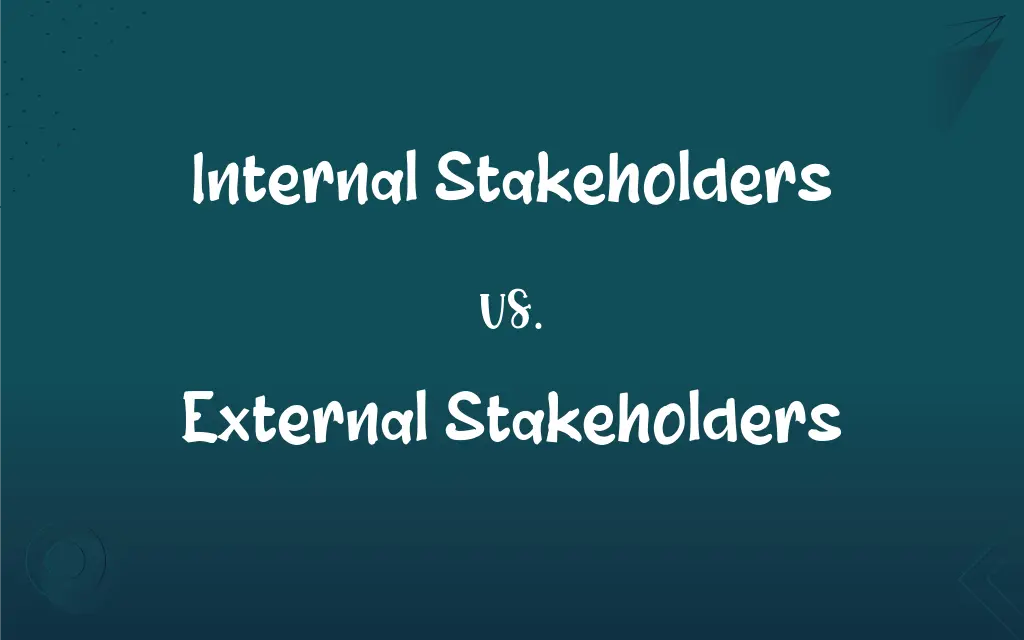Internal Stakeholders vs. External Stakeholders: What's the Difference?
Edited by Janet White || By Harlon Moss || Updated on October 8, 2023
Internal stakeholders are individuals/groups within an organization, while external stakeholders are outside entities that are affected by or affect the organization's decisions and activities.

Key Differences
Internal stakeholders are fundamentally entities within a particular organization that have a stake, or interest, in the activities and performance of the company. Examples of internal stakeholders include employees, managers, and owners. External stakeholders, conversely, refer to individuals or groups outside the company who are influenced by or can influence the organization's decisions. They may encompass customers, suppliers, investors, and more.
In-depth, internal stakeholders such as employees are directly involved in the day-to-day operations and outcomes of a company. Their performance and decision-making directly impact the business’s success. Meanwhile, external stakeholders, such as suppliers, may not be involved in the daily operations but can significantly influence the company by, for instance, altering the supply of materials, which can directly affect the business’s production capabilities and continuity.
When considering the strategic decisions of an organization, internal stakeholders may have more immediate impacts due to their intrinsic roles within the company. Decisions, such as changes in operational procedures, directly affect internal stakeholders like employees and managers. Conversely, external stakeholders, such as the community or regulatory bodies, often have an indirect or longer-term impact, through regulatory compliance, reputation management, or community relations, which can consequently influence the organization’s operational framework and strategy.
Lastly, internal stakeholders generally have a close, integral connection with the company, often with direct access to organizational resources and information. They contribute to and are immediately affected by the company's strategies and policies. External stakeholders, while they may hold significant influence and interest, might not have the same level of access or immediate impact on the organization, yet their roles and reactions to organizational decisions remain pivotal, shaping the external environment in which the company operates.
Comparison Chart
Association with Company
Directly associated and work within the company.
Not part of the company, associate externally.
ADVERTISEMENT
Impact and Influence
Have direct and immediate impact and influence.
Influence and are influenced more indirectly.
Access to Information
Typically have direct access to company info.
May not have direct access to detailed internal info.
Investment in Company
Often have a direct investment (time, skills).
May have indirect investment (money, resources).
Example Entities
Employees, managers, owners.
Customers, suppliers, community, regulators.
Internal Stakeholders and External Stakeholders Definitions
Internal Stakeholders
Internal stakeholders often contribute to the organizational decisions and strategies.
As internal stakeholders, the board of directors played a pivotal role in decision-making.
ADVERTISEMENT
External Stakeholders
These stakeholders do not typically have direct access to an organization’s internal workings.
The external stakeholders were unaware of the detailed financial troubles of the company.
Internal Stakeholders
They are usually directly affected by the company’s policies and strategies.
The new working hours policy directly impacted the internal stakeholders, especially the staff.
External Stakeholders
Their relationships with an organization may focus on exchange, regulatory compliance, and reputation management.
External stakeholders, like environmental regulators, ensured the company adhered to legal standards.
Internal Stakeholders
Internal stakeholders are individuals or groups within an organization.
The employees, as internal stakeholders, were keenly interested in the company’s new policy.
External Stakeholders
External stakeholders are entities outside an organization that have an interest in its operations.
The local community, as external stakeholders, expressed concerns about the company’s environmental practices.
Internal Stakeholders
Internal stakeholders typically have access to exclusive company information.
The internal stakeholders, including team leaders, were privy to the upcoming organizational changes.
External Stakeholders
External stakeholders can include customers, suppliers, investors, and regulatory bodies.
Suppliers, critical external stakeholders, were affected by the company’s bankruptcy.
Internal Stakeholders
They have direct involvement and interest in the company's activities and performance.
The managers, internal stakeholders, strategized to enhance company profits.
External Stakeholders
They may influence or be influenced by an organization’s decisions and activities.
The external stakeholders, particularly customers, were impacted by the product recall.
FAQs
Can internal stakeholders include temporary staff?
Yes, temporary staff can be considered internal stakeholders as they work within the organization.
How do internal stakeholders impact a company?
They directly influence and are influenced by its strategies, decisions, and performance.
Who are considered external stakeholders?
Entities outside an organization, like customers, suppliers, and regulatory bodies.
How might a company mitigate negative impacts from external stakeholders?
By engaging in effective communication, crisis management, and building positive relationships.
What are internal stakeholders?
Individuals or groups within an organization, such as employees or owners.
How can internal stakeholders benefit a company?
Their skills, knowledge, and engagement can drive productivity and innovation.
What is a key concern of internal stakeholders in a company’s operation?
Concerns can include job security, workplace culture, and the company’s financial stability.
Why are external stakeholders important?
They can affect or be affected by an organization’s actions and performance, influencing its reputation and operations.
What’s an example of an internal stakeholder’s influence?
Employees can impact a company through their productivity and engagement levels.
Can external stakeholders impact a company’s reputation?
Yes, through reviews, investments, and public perceptions, they can significantly impact its reputation.
What responsibility do internal stakeholders have toward a company?
To perform roles effectively, uphold company values, and engage in organizational activities.
Do external stakeholders have responsibilities toward a company?
Indirectly, in maintaining ethical dealings and abiding by legal and regulatory norms in interactions.
Can a company be an external stakeholder in another company?
Yes, if a company influences or is influenced by another company, it can be considered an external stakeholder.
How are internal stakeholders communicated with?
Through internal communications like emails, meetings, and intranet platforms.
Do internal stakeholders usually have a financial stake in the company?
Often, especially if they are owners or investors, but not always, as with employees.
How can external stakeholders impact a company’s market position?
Through purchasing behaviors, investments, and societal influences, they can impact market perceptions and standings.
Can negative publicity from external stakeholders affect a company?
Absolutely, negative publicity can impact a company’s reputation and financial performance.
Can internal stakeholders influence company policy?
Yes, through their roles, feedback, and performances, they can influence policy and strategic decisions.
How do external stakeholders express their interests?
Through purchasing behaviors, investments, community engagements, and regulatory frameworks.
How do companies engage with external stakeholders?
Through PR, customer service, social media, and regulatory compliance, among others.
About Author
Written by
Harlon MossHarlon is a seasoned quality moderator and accomplished content writer for Difference Wiki. An alumnus of the prestigious University of California, he earned his degree in Computer Science. Leveraging his academic background, Harlon brings a meticulous and informed perspective to his work, ensuring content accuracy and excellence.
Edited by
Janet WhiteJanet White has been an esteemed writer and blogger for Difference Wiki. Holding a Master's degree in Science and Medical Journalism from the prestigious Boston University, she has consistently demonstrated her expertise and passion for her field. When she's not immersed in her work, Janet relishes her time exercising, delving into a good book, and cherishing moments with friends and family.
































































